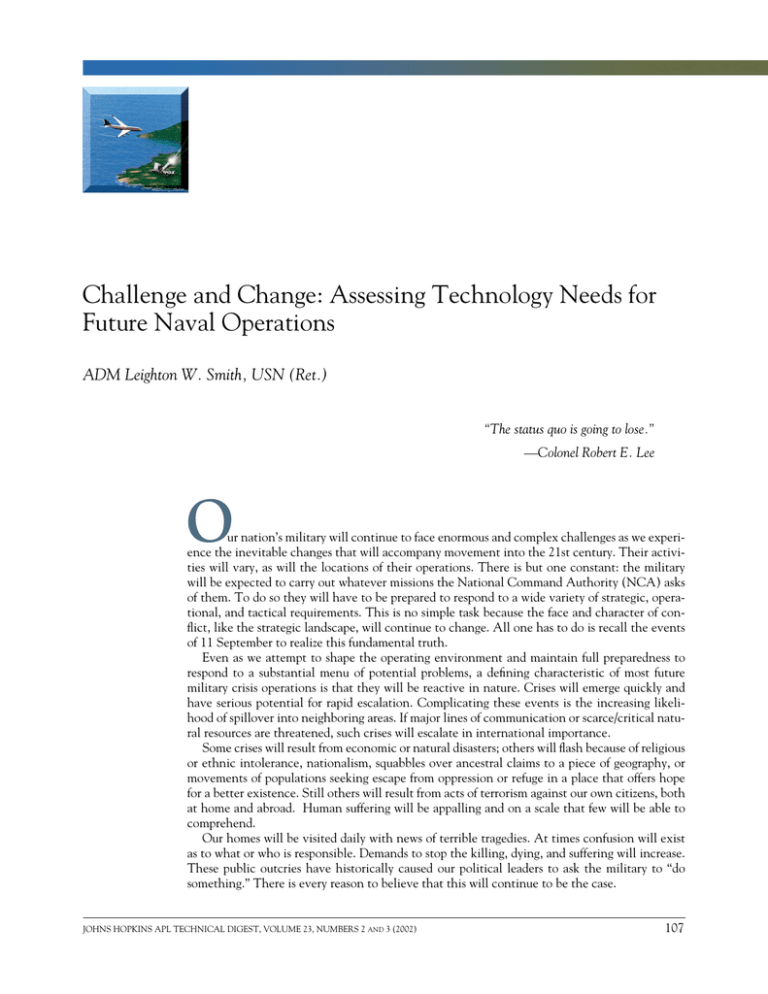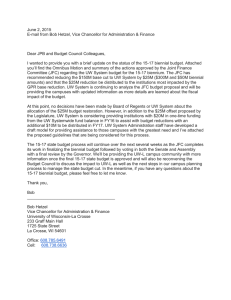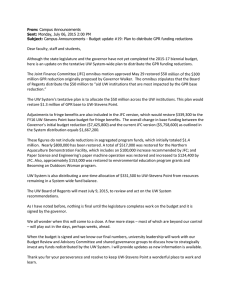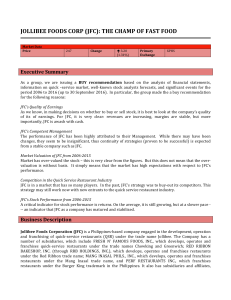O Challenge and Change: Assessing Technology Needs for Future Naval Operations
advertisement

TECHNOLOGY NEEDS FOR NAVAL OPERATIONS Challenge and Change: Assessing Technology Needs for Future Naval Operations ADM Leighton W. Smith, USN (Ret.) “The status quo is going to lose.” —Colonel Robert E. Lee O ur nation’s military will continue to face enormous and complex challenges as we experience the inevitable changes that will accompany movement into the 21st century. Their activities will vary, as will the locations of their operations. There is but one constant: the military will be expected to carry out whatever missions the National Command Authority (NCA) asks of them. To do so they will have to be prepared to respond to a wide variety of strategic, operational, and tactical requirements. This is no simple task because the face and character of conflict, like the strategic landscape, will continue to change. All one has to do is recall the events of 11 September to realize this fundamental truth. Even as we attempt to shape the operating environment and maintain full preparedness to respond to a substantial menu of potential problems, a defining characteristic of most future military crisis operations is that they will be reactive in nature. Crises will emerge quickly and have serious potential for rapid escalation. Complicating these events is the increasing likelihood of spillover into neighboring areas. If major lines of communication or scarce/critical natural resources are threatened, such crises will escalate in international importance. Some crises will result from economic or natural disasters; others will flash because of religious or ethnic intolerance, nationalism, squabbles over ancestral claims to a piece of geography, or movements of populations seeking escape from oppression or refuge in a place that offers hope for a better existence. Still others will result from acts of terrorism against our own citizens, both at home and abroad. Human suffering will be appalling and on a scale that few will be able to comprehend. Our homes will be visited daily with news of terrible tragedies. At times confusion will exist as to what or who is responsible. Demands to stop the killing, dying, and suffering will increase. These public outcries have historically caused our political leaders to ask the military to “do something.” There is every reason to believe that this will continue to be the case. JOHNS HOPKINS APL TECHNICAL DIGEST, VOLUME 23, NUMBERS 2 and 3 (2002) 107 L. W. SMITH Some of the factors influencing military effectiveness are • U.S. investment in information technologies that have far outpaced our allies and potential partners • Lack of common command and control capabilities • Inability to share common intelligence data; weapons systems that cannot share information • Weapons that are incompatible with the delivery platforms of our partners • Strategic lift These factors, however, will not alter reality: our forces, no matter what the challenge, must prevail—quickly, decisively, and with minimum loss of equipment and few casualties. And even though many of our operations could be confined geographically (urban terrain), there will be little stomach for collateral damage and none for fratricide (“blue on blue”). A complicating factor is that potential adversaries have greater access to technologies and weapons that could challenge even the most prepared and powerful military force. Weapons of mass destruction, ballistic missiles, supersonic sea-skimming missiles, stealthy or low observable technologies, precision guided munitions (PGMs), and a large variety of “conventional arms” with standoff capabilities will be available to those who can afford them. The lethality of some of these capabilities and the enormity of their “political statement” suggest that small, rogue nations or terrorist elements could use just one or two to achieve their aims. The new term is “asymmetric threat.” To some degree, the ability to penetrate our information systems has already been demonstrated; our C4ISR (command and control, communications, computers, intelligence, surveillance and reconnaissance) systems and weapons systems (e.g., firing commands, guidance and control commands) will be targets. Firewalls within our information systems must be developed that will allow for selective promulgation of data. Equally important is the necessity for full protection from intrusion. FUTURE MISSION REQUIREMENTS Given the challenges of change and the complex and diversified operating environment, what capabilities must the military have to carry out their missions? Establish Dominance in the Battlespace First, a Joint Force Commander (JFC) must rapidly establish dominance in the operating battlespace. To do so he must fully understand it. This requires thorough intelligence preparation based on current intelligence specifically tailored for the area of intended operations. Therefore, a rapidly developed and dynamic intelligence gathering plan, using computer power to maximize the 108 qualitative and quantitative capabilities of all available assets, is essential. The decision to deploy sensors must be made on very short notice (or none at all). These sensors must have the endurance, redundancy, and survivability necessary to remain on station for as long as required to develop the needed information. They must be tailorable to JFC guidance, capable of long-range detection of incoming aircraft or missiles, accurate to within the CEP (circular error probability) of our best PGMs (it does no good to fire a weapon with a 3-m CEP at a target whose location is fixed to only 10 m), timely, agile, and all-weather. They also must have onboard processing and fusion capabilities and be able to communicate among themselves in real or near–real time. Obviously, the information and the manner in which it is transmitted must be carefully protected. Without these basics, the JFC cannot develop his concept of operations or intent and guidance. Nor can he adequately position his assets to ensure the protection of his forces and defeat of an illusive enemy. Assess Risks and Develop a Plan In the early stages of a potential conflict, and likely well into it, the JFC will not have all of the equipment and forces needed to achieve his objectives. It is in this stage that his forces will be the most vulnerable. Consequently, one of his principal responsibilities will be to assess risks and allocate shortages. To do this the JFC will need to understand the effectiveness of available assets. In light of the advent of such threats as tactical ballistic missiles, unmanned aerial vehicles, and airlaunched standoff weapons, an initial challenge will be to establish the most effective defense against them. The commander will need to know more than just the enemy’s order of battle and location; he will need to understand enemy capabilities in order to accurately predict the adversary’s intentions. He will want to consider a range of possible courses of action by his opponent and then have the capability to collaboratively develop counters to each. Given the dynamics of the battlespace, the planning function must optimize the positioning of all available assets over time and allow for “planning on the fly.” A static plan simply will not suffice. Predictive intelligence and the ability to “see” the battlespace in three dimensions will provide an enormous advantage to the JFC because he can quickly assimilate the myriad inputs of information and turn them into knowledge. With this level of knowledge, the commander and his staff can remain well inside the adversary’s decision cycle, a key ingredient to success on any battlefield, and most assuredly so in those we can expect in the future. Before committing to a plan (and certainly as an operation begins to unfold), the JFC will want to JOHNS HOPKINS APL TECHNICAL DIGEST, VOLUME 23, NUMBERS 2 and 3 (2002) TECHNOLOGY NEEDS FOR NAVAL OPERATIONS understand the sequencing of force activities and the impact of one move (or its delay) on the totality of the plan. In addition, he will need to consider whether his scheme of maneuver, as well as his tempo of operations, is outpacing his ability to appropriately defend and sustain his forces. Once the plan has been developed, it must be disseminated quickly to all participants. Critical to the success of any operation is a full understanding of what the JFC expects of subordinate commanders. There is no room for error here. Today’s operations are complex; tomorrow’s may be even more so. Ideally, any force heading into harm’s way would be better prepared if it could practice what it is about to undertake. The timing of future crises will very likely not provide the opportunity for a dress rehearsal. The next best thing is to test the plan through “wargaming” and to exercise the staffs through embedded training capabilities. Future systems must incorporate these fundamental capabilities. Ensure Access Once the JFC has an understanding of the battlespace and has developed plans to achieve the mission, he must have full access and unencumbered freedom of maneuver in the area of operations. He will want to be able to project decisive power at the time and place of his choosing. He may wish to quickly deploy light, versatile, and lethal forces or he may need to establish a lodgment in order to deploy and build up a heavy force with the requisite supporting infrastructure. Force size will not matter, but rather the ability to create conditions for the successful and sequenced introduction of that force, whenever and wherever the JFC chooses to operate. Impediments to access are a variety of sophisticated and deadly marine and land mines, submarines, missile systems, and aircraft with PGMs. The JFC cannot wish these very real threats away. He must therefore have the technologies to deal with them in real time, including the capability to detect their presence, track or map them accurately, and understand the extent of their impact on his forces. He then must have the ability to suppress, neutralize, or destroy them. While this may appear to be a relatively straightforward and simple task, it is not. During Desert Storm, for example, we did not have the capability to locate and attack a missile launcher before it could strike a potentially devastating blow. Weapons that can destroy such a threat are of little value if they cannot be launched and reach the enemy target before it can fire. We must be able to detect launchers as they move into firing position, fix their positions to within the CEP of our most accurate PGMs, pair weapons to individual targets (this implies that we have a continuous and accurate inventory of available offensive weapons and can get the targeting data to them), deconflict the airspace between the shooter and target, and gain agreement among the various “interested parties” to launch an attack. We must be able to do all of this in minutes, if not seconds, or the forces within range are at risk. If accuracy of fires and the ability to bring weapons to bear on a target quickly are important, so too is volume of fire. In some instances units in contact will require more than the destruction of a few targets. They will need a sustained level of fire over hours or perhaps days in order to achieve their objective. This is not a trivial problem. Technologies that reduce weapon size, improve their lethality, make them more accurate, allow for safe storage of large quantities, and lead to newer and faster replenishment and resupply will help solve this fundamental problem. Sustain the Force over Time An extension of the volume of fire issue is the problem of sustaining a force over time. During Desert Storm we had a fair understanding of what would be needed to defeat Saddam Hussein but little knowledge of what was available. The net result was a logistics nightmare. Thousands of containers with needed weapons and equipment were on hand, but the right people did not know where those containers were or what their specific contents were. Technologies can reduce the uncertainties associated with force sustainment by developing ways to accurately project usage rates for expendables, better predict repairables requirements, and develop the means to provide equipment and parts where and when they are needed. These technologies, or the benefits derived therefrom, should be incorporated into planning capabilities so that the JFC can understand the impact of logistics on his planned scheme of maneuver and his desired tempo of operations. The question he will ask is, Will my plan drive the logistics, or will the logistics drive (i.e., restrict) my plan? If the answer is the latter, his chances of achieving rapid dominance of the battlespace and overall success in the mission will be substantially impaired. CONCLUSION This article has provided insights into just a few of the many significant issues and problems facing a commander of a Joint force in the future. It has also highlighted the fact that the future will be defined by challenge and change. While we never really know what the next mission might be, we do know that remaining on the leading edge of technological innovations will give our forces the competitive advantage that will allow them to prevail, no matter what the task. JOHNS HOPKINS APL TECHNICAL DIGEST, VOLUME 23, NUMBERS 2 and 3 (2002) 109 L. W. SMITH Our challenge is to think like the warfighting commander of a Joint or Coalition force. What are his issues? What does he really need? When does he really need it? How can delivery be assured? If we can answer these questions, we can anticipate what technologies can do to create the conditions for successful operations. That is our challenge. THE AUTHOR ADM LEIGHTON W. SMITH, USN (Ret.), graduated from the U.S. Naval Academy in 1962 and received his wings in January 1964. As a Navy attack pilot, he flew 280 missions in Vietnam. By 1983, he was the Assistant Chief of Staff for Readiness, Naval Air Force, for the U.S. Atlantic Fleet, and by 1988 he was the Commander of the Navy’s Carrier Group 6. From 1989 through 1991 (when he became a fourstar Admiral), he was the Director of Operations, U.S. European Command J-3. In 1992, he published From the Sea, an outline of the Navy’s strategy for the 21st century. In 1994, he became the Commander in Chief, U.S. Navy Forces Europe and NATO Allied Forces Southern Europe. In this capacity, he led NATO operations in Bosnia. He retired in 1996 with over 40 medals after over 34 years of service. ADM Smith has worked closely with APL in advising the Laboratory on development of leading-edge technology prototypes for introduction into Joint operations. (Photo courtesy of the NATO Office of Information and Press, Brussels, Belgium.) 110 JOHNS HOPKINS APL TECHNICAL DIGEST, VOLUME 23, NUMBERS 2 and 3 (2002)





